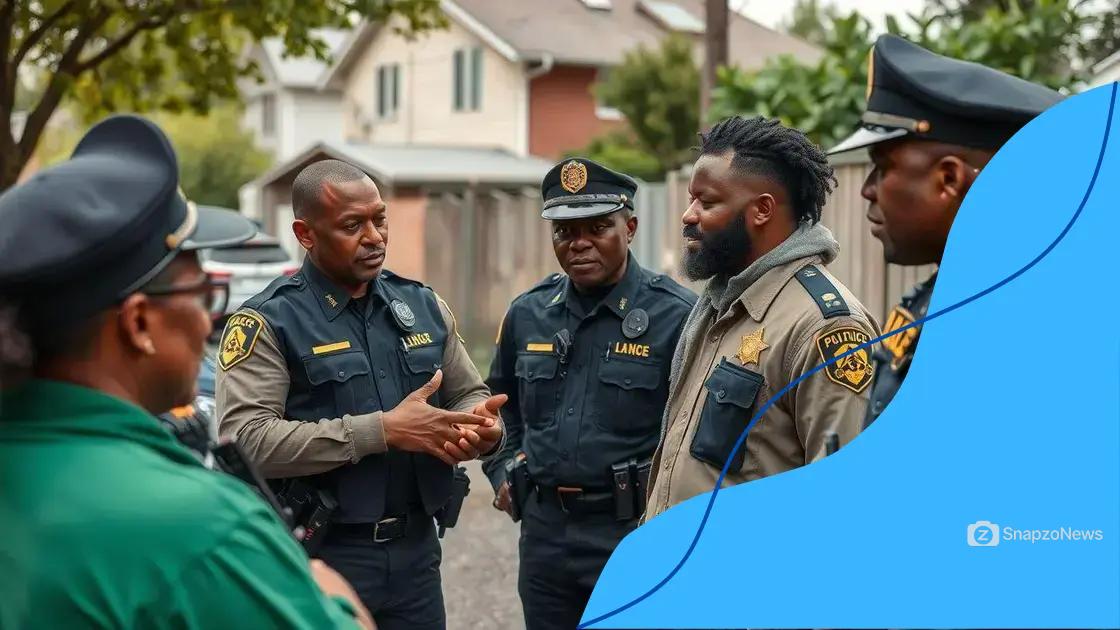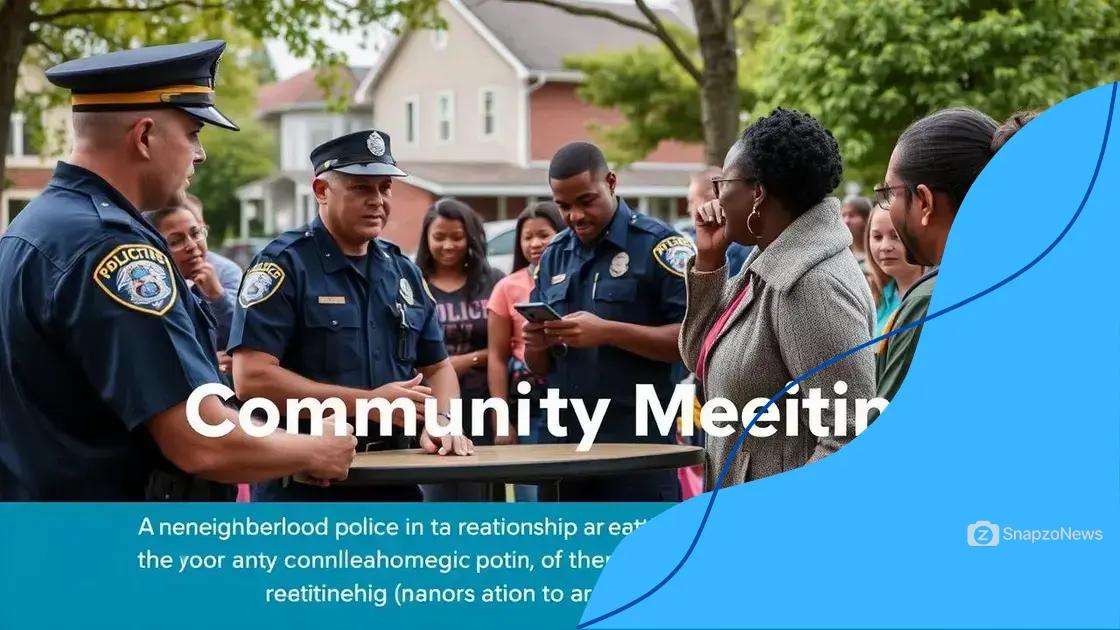Debates on the future of US law enforcement

Debates on the future of US law enforcement focus on community policing, technological integration, accountability, and public trust to create safer communities and adapt to changing societal needs.
Debates on the future of US law enforcement are more relevant than ever as society grapples with issues of equity and safety. Have you ever wondered how these discussions shape our communities? In this article, we’ll dive into the key elements of this ongoing conversation.
Current trends in US law enforcement
In recent years, the landscape of US law enforcement has been significantly impacted by various trends that reflect societal changes and advancements in technology. Understanding these trends is vital for grasping how they influence police practices and public safety.
The rise of community-oriented policing
One of the most important trends is the shift towards community-oriented policing. This strategy focuses on building strong relationships between law enforcement and the communities they serve. By fostering trust, officers can work more effectively with community members to solve problems.
Technology in policing
Another major trend involves the increasing use of technology in policing. Tools such as body-worn cameras, drones, and data analytics are becoming common. These innovations help improve transparency and accountability. However, they also raise important questions about privacy and civil rights.
- Body cameras enhance police accountability.
- Drones support surveillance and crime scene analysis.
- Data analytics improve resource allocation and crime prediction.
Moreover, there is a growing emphasis on addressing mental health issues within law enforcement. Training officers to handle situations involving mental health crises is crucial. This approach not only aids individuals in distress but also ensures the safety of all parties involved.
Calls for reform
Public demand for police reform has surged, leading to discussions about policy changes. Many communities are seeking to rethink policing methods, focusing on alternatives to traditional law enforcement. This includes diversifying police forces and implementing de-escalation tactics during confrontations.
Finally, community engagement has become a priority. Many departments are holding town hall meetings to understand better the needs of the public. This engagement fosters an environment of collaboration, which can lead to innovative solutions to reduce crime and improve safety.
Key challenges facing law enforcement today
Law enforcement agencies are currently facing a multitude of challenges that impact their ability to maintain public safety effectively. These challenges often stem from social, political, and technological factors that are continually evolving.
Maintaining public trust
One of the most pressing issues is maintaining public trust. High-profile incidents of police misconduct have sparked widespread protests and calls for reform. Building trust with communities is essential, as it encourages cooperation between police and the public.
Resource limitations
Another significant challenge is the limitation of resources. Many law enforcement agencies struggle with budget constraints that affect their staffing, training, and equipment. This leads to increased workloads for officers and can impact their overall effectiveness.
- Inadequate funding limits training opportunities.
- Insufficient staffing can lead to burnout.
- Outdated equipment hinders officers’ performance.
The growing complexity of crime also poses a challenge. Crimes are becoming more sophisticated, often involving technology and cyber elements. Officers need specialized training to effectively tackle these issues, but resources may not always be available.
Community relations
Community relations remain a crucial aspect of effective policing. Officers must engage with the community to address fears and concerns. When police are seen as part of the community rather than an outsider force, it fosters cooperation.
Additionally, law enforcement faces scrutiny from various advocacy groups demanding accountability and transparency. As these groups push for changes, agencies must find ways to adapt without compromising their operational effectiveness.
Lastly, the rise of social media has changed the landscape of communication. Misinformation can spread quickly, leading to public outcries based on inaccurate information. Law enforcement must navigate these challenges while providing clear and timely communication to the public.
The role of community policing in reforms

Community policing plays a vital role in law enforcement reforms. This approach encourages collaborative partnerships between the police and community members. By working together, they can address safety concerns and build trust.
Building relationships
One of the main goals of community policing is to establish strong relationships. Officers engage regularly with residents through events, meetings, and outreach programs. These interactions foster a sense of belonging and allow police to understand community needs better.
Preventing crime
Community policing also focuses on crime prevention. Instead of solely responding to calls for service, officers work proactively to address issues before they escalate. By identifying patterns and involving community members, police can implement strategies to reduce crime.
- Neighborhood watch programs enhance community vigilance.
- Local events strengthen bonds between residents and police.
- Educational workshops empower citizens to participate in public safety.
Moreover, this strategy prioritizes accountability. Officers are encouraged to be transparent in their actions, which can build confidence within the community. When people see officers taking responsibility for their actions, it contributes to a positive relationship.
Empowering communities
Community policing empowers residents to take an active role in their own safety. When community members feel safe discussing their concerns, it leads to collaborative problem-solving. This partnership can involve organizing community forums where residents voice concerns and suggest solutions alongside law enforcement.
The implementation of community policing requires proper training for officers. They must develop skills in communication, conflict resolution, and cultural understanding. As they learn these skills, they become better equipped to serve diverse communities effectively.
Impact of technology on policing practices
The impact of technology on policing practices has transformed the way law enforcement operates today. Advances in technology have created new tools that help officers improve their efficiency and effectiveness in ensuring public safety.
Use of body-worn cameras
One significant advancement is the use of body-worn cameras by police officers. These cameras provide a record of interactions between officers and the public, promoting transparency and accountability. This technology can deter misconduct and help in evidence collection.
Data analytics
Data analytics plays a crucial role in modern policing as well. Law enforcement agencies can analyze crime patterns and trends through data. This allows them to allocate resources more effectively and develop strategies focused on crime prevention.
- Crime mapping identifies high-risk areas.
- Predictive analytics helps prevent future crimes.
- Data sharing improves cooperation between departments.
Additionally, technology has revolutionized communication within police departments. With improved communication tools, officers can now receive instant updates about incidents, enabling quicker response times. This capability greatly enhances the overall efficiency of law enforcement.
Social media and community engagement
The emergence of social media has changed how police engage with the community. Many departments use platforms like Twitter and Facebook to share information, safety tips, and updates on local incidents. This direct communication fosters a connection between the police and the community.
While technology offers many benefits, it also raises concerns, particularly regarding privacy. The use of surveillance cameras and data collection must be balanced with individuals’ rights to privacy. Law enforcement must ensure that technology is used responsibly and ethically.
Future visions for law enforcement in America
The future visions for law enforcement in America are being shaped by a combination of community needs, technological advancements, and innovative practices. As society evolves, so too must the strategies that law enforcement agencies employ to ensure safety and justice.
Embracing community partnerships
One key vision for the future is the continued emphasis on community partnerships. Building strong relationships between police and community members is essential for improving public trust. Police departments are likely to expand community policing efforts, working hand-in-hand with residents to solve problems and enhance public safety.
Integration of technology
The integration of advanced technology will play a critical role in shaping future law enforcement practices. Expect to see more use of artificial intelligence and machine learning in resource allocation, predictive policing, and data analysis. These technologies can help officers respond more effectively to incidents and reduce crime rates efficiently.
- AI can assist in identifying crime patterns.
- Mobile applications may allow the public to report incidents easily.
- Virtual reality training could prepare officers for real-life scenarios.
Additionally, there will be a stronger focus on mental health resources within law enforcement. Recognizing the importance of mental wellness, police agencies will likely invest in training that equips officers to handle crises more effectively. This will enhance the overall safety and security of both officers and the communities they serve.
Accountability and transparency
Accountability will remain a cornerstone of future policing. As citizens demand transparency in law enforcement operations, agencies will adopt practices that increase openness. Body cameras and public reporting on police actions will become standard, helping build trust with community members.
Ultimately, the future of law enforcement in America will hinge on the ability to adapt to a changing social landscape. By embracing new strategies and technologies, law enforcement can work to create safer communities while promoting justice and fairness.
FAQ – Frequently Asked Questions about the Future of Law Enforcement in America
What role does community policing play in law enforcement reforms?
Community policing focuses on building strong relationships between police and the community, which helps to improve public trust and cooperation.
How is technology changing policing practices?
Technology, including AI and data analytics, enhances policing by improving resource allocation and enabling predictive policing strategies.
What are the key challenges facing law enforcement today?
Key challenges include maintaining public trust, resource limitations, and the need for improved accountability and transparency.
How can law enforcement ensure accountability and transparency?
By implementing body-worn cameras and maintaining open communication with the public, law enforcement can enhance accountability and transparency.
